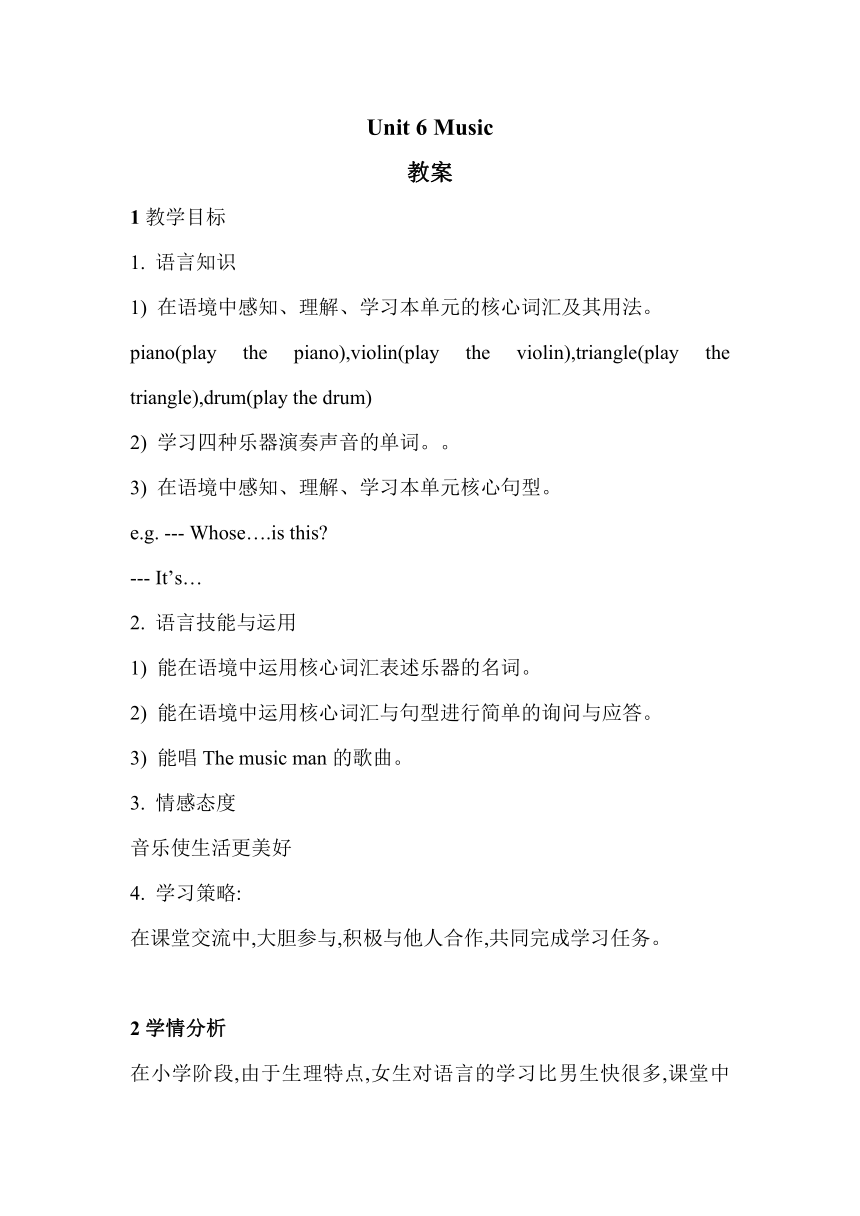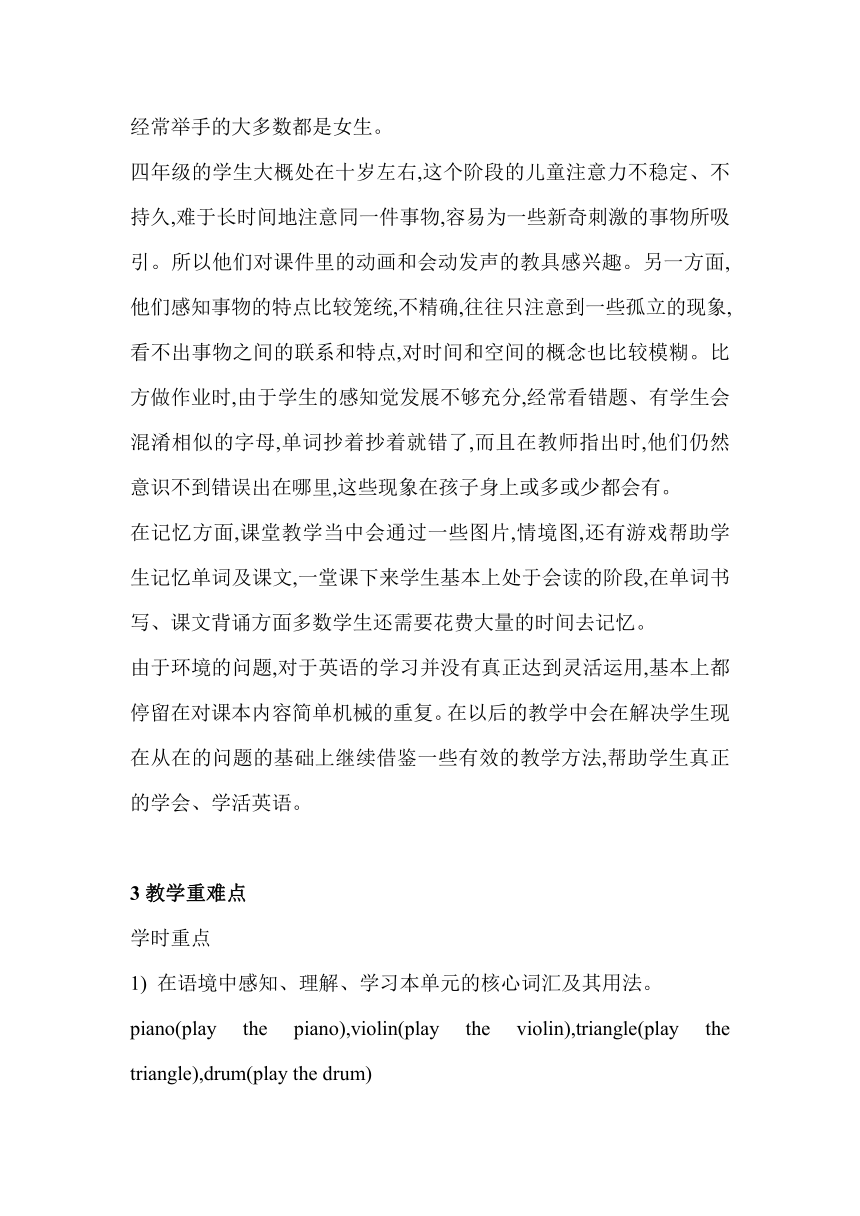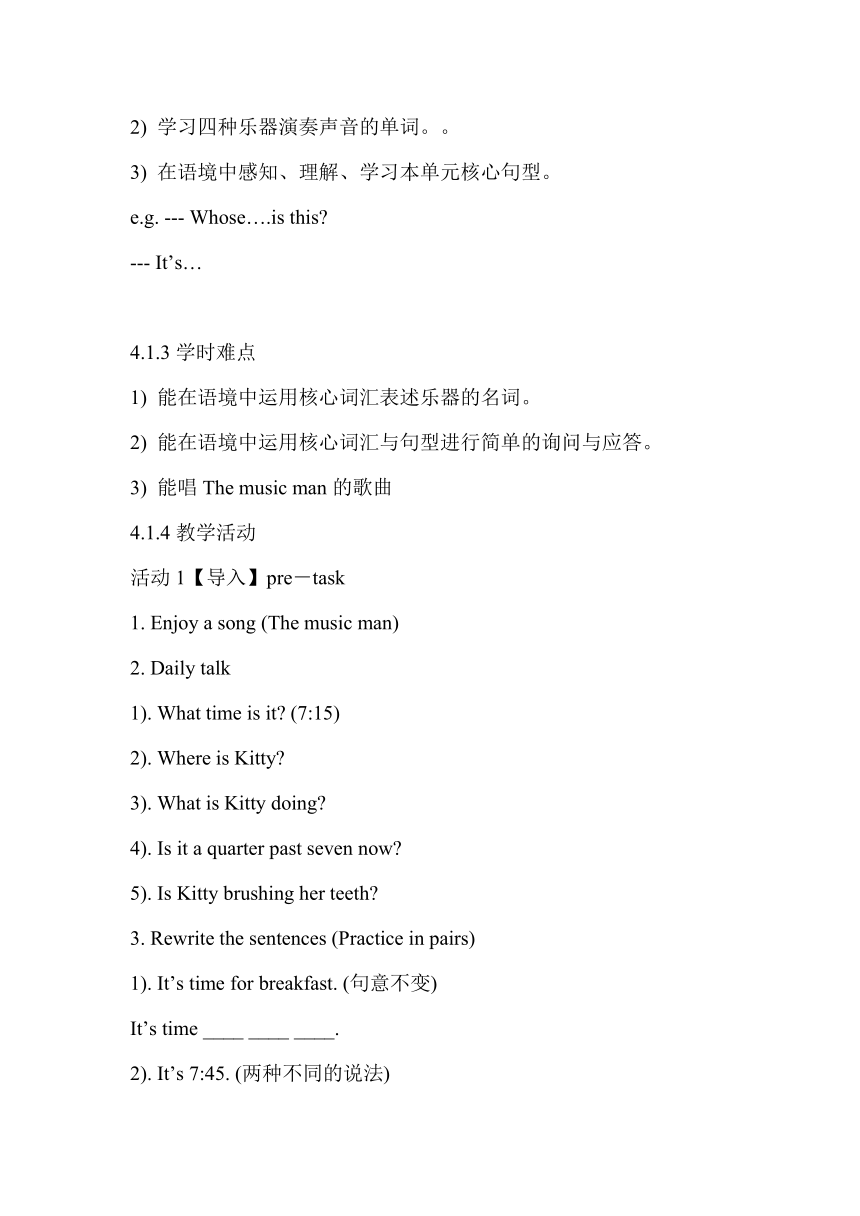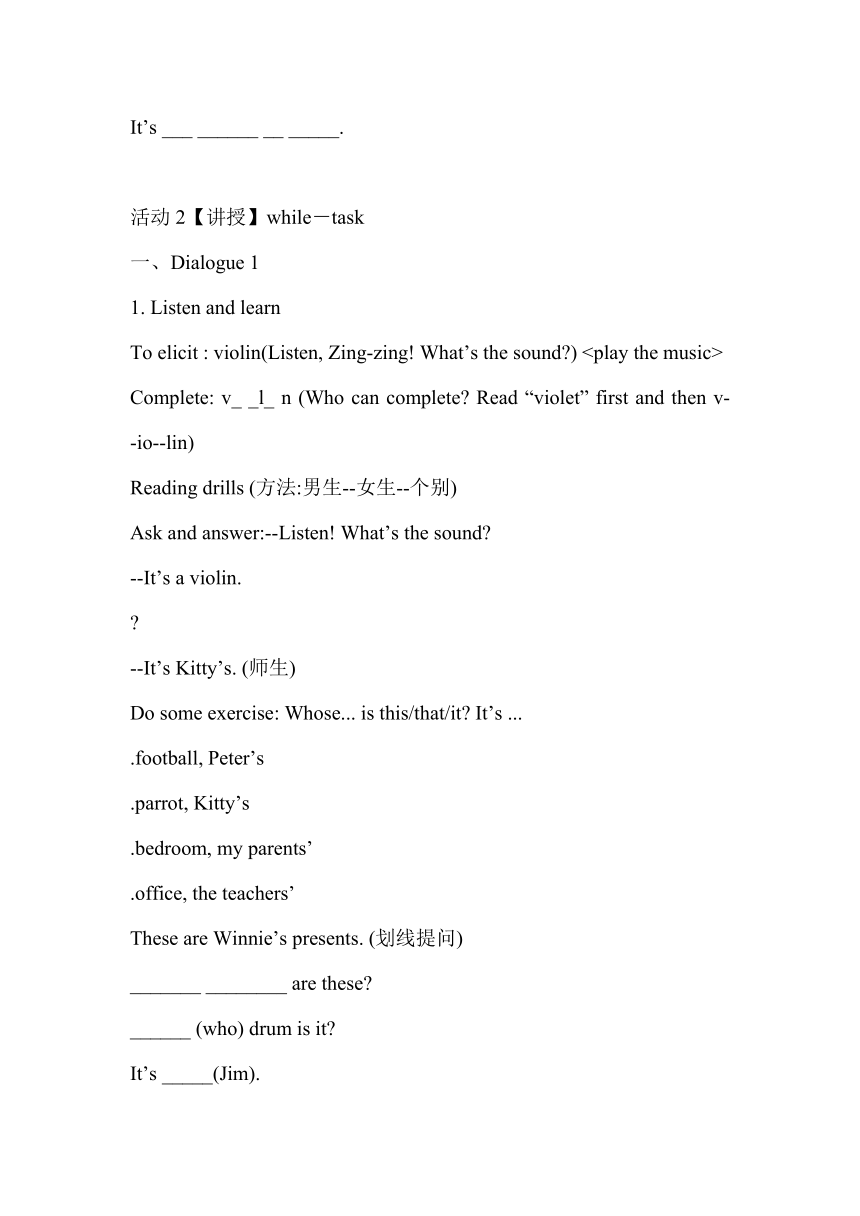Unit 6 Music 第一课时教案
文档属性
| 名称 | Unit 6 Music 第一课时教案 |  | |
| 格式 | zip | ||
| 文件大小 | 120.6KB | ||
| 资源类型 | 教案 | ||
| 版本资源 | 牛津沪教版 | ||
| 科目 | 英语 | ||
| 更新时间 | 2017-05-25 19:31:48 | ||
图片预览




文档简介
Unit
6
Music
教案
1教学目标
1.
语言知识
1)
在语境中感知、理解、学习本单元的核心词汇及其用法。
piano(play
the
piano),violin(play
the
violin),triangle(play
the
triangle),drum(play
the
drum)
2)
学习四种乐器演奏声音的单词。。
3)
在语境中感知、理解、学习本单元核心句型。
e.g.
---
Whose….is
this
---
It’s…
2.
语言技能与运用
1)
能在语境中运用核心词汇表述乐器的名词。
2)
能在语境中运用核心词汇与句型进行简单的询问与应答。
3)
能唱The
music
man的歌曲。
3.
情感态度
音乐使生活更美好
4.
学习策略:
在课堂交流中,大胆参与,积极与他人合作,共同完成学习任务。
2学情分析
在小学阶段,由于生理特点,女生对语言的学习比男生快很多,课堂中经常举手的大多数都是女生。
四年级的学生大概处在十岁左右,这个阶段的儿童注意力不稳定、不持久,难于长时间地注意同一件事物,容易为一些新奇刺激的事物所吸引。所以他们对课件里的动画和会动发声的教具感兴趣。另一方面,他们感知事物的特点比较笼统,不精确,往往只注意到一些孤立的现象,看不出事物之间的联系和特点,对时间和空间的概念也比较模糊。比方做作业时,由于学生的感知觉发展不够充分,经常看错题、有学生会混淆相似的字母,单词抄着抄着就错了,而且在教师指出时,他们仍然意识不到错误出在哪里,这些现象在孩子身上或多或少都会有。
在记忆方面,课堂教学当中会通过一些图片,情境图,还有游戏帮助学生记忆单词及课文,一堂课下来学生基本上处于会读的阶段,在单词书写、课文背诵方面多数学生还需要花费大量的时间去记忆。
由于环境的问题,对于英语的学习并没有真正达到灵活运用,基本上都停留在对课本内容简单机械的重复。在以后的教学中会在解决学生现在从在的问题的基础上继续借鉴一些有效的教学方法,帮助学生真正的学会、学活英语。
3教学重难点
学时重点
1)
在语境中感知、理解、学习本单元的核心词汇及其用法。
piano(play
the
piano),violin(play
the
violin),triangle(play
the
triangle),drum(play
the
drum)
2)
学习四种乐器演奏声音的单词。。
3)
在语境中感知、理解、学习本单元核心句型。
e.g.
---
Whose….is
this
---
It’s…
4.1.3学时难点
1)
能在语境中运用核心词汇表述乐器的名词。
2)
能在语境中运用核心词汇与句型进行简单的询问与应答。
3)
能唱The
music
man的歌曲
4.1.4教学活动
活动1【导入】pre-task
1.
Enjoy
a
song
(The
music
man)
2.
Daily
talk
1).
What
time
is
it
(7:15)
2).
Where
is
Kitty
3).
What
is
Kitty
doing
4).
Is
it
a
quarter
past
seven
now
5).
Is
Kitty
brushing
her
teeth
3.
Rewrite
the
sentences
(Practice
in
pairs)
1).
It’s
time
for
breakfast.
(句意不变)
It’s
time
____
____
____.
2).
It’s
7:45.
(两种不同的说法)
It’s
___
______
__
_____.
活动2【讲授】while-task
一、Dialogue
1
1.
Listen
and
learn
To
elicit
:
violin(Listen,
Zing-zing!
What’s
the
sound )
the
music>
Complete:
v_
_l_
n
(Who
can
complete
Read
“violet”
first
and
then
v-
-io--lin)
Reading
drills
(方法:男生--女生--个别)
Ask
and
answer:--Listen!
What’s
the
sound
--It’s
a
violin.
--It’s
Kitty’s.
(师生)
Do
some
exercise:
Whose...
is
this/that/it
It’s
...
.football,
Peter’s
.parrot,
Kitty’s
.bedroom,
my
parents’
.office,
the
teachers’
These
are
Winnie’s
presents.
(划线提问)
_______
________
are
these
______
(who)
drum
is
it
It’s
_____(Jim).
Are
____
(this)
your
drums
No,
_____(we)
drums
are
white.
Learn:
play
the
violin
(Can
Kitty
play
the
violin )
,
she
can
play
the
violin.
(Read
drills)
To
elicit
:It
goes
“Zing-zing!”.
2.
Read
the
dialogue
1
(方法:跟读-
-齐读)
3.
Conclude
together(方法:以问答的方式贴板书并齐读)
<板书:Musical
instrument
Whose
Can
Sound
violin
Kitty’s
Zing-zing>
It’s
a
violin.
It’s
Kitty’s
violin.
Kitty
can
play
the
violin.
It
goes
“Zing-zing!”
二、Dialogue
2
1.
Listen
and
review:
triangle
(Kitty
can
play
the
violin
very
well.
Listen,
what
can
Peter
play )
1)
To
review:
triangle
(Yes,
Peter
can
play
the
triangle
and
can
you
spell
it )
2)
spell(方法:抽人)-
-
read-
-
spell
again(方法:齐拼)
3)
Learn:
play
the
triangle
4)
Compare:
I
can
play
the
triangle.
This
biscuit
is
a
triangle.
The
triangle
is
a
triangle.
What’s
the
meaning
of
“triangle”.
(抽同学分享然后显示正确答案)
(Whose
triangle
is
this
-
-
The
triangle
goes…)
5)
Elicit:
It
goes
“Ting-ting!”
Read
drill
6)
Fill
and
read
Dialogue
2(方法:同桌练习,角色扮演)
2.
Conclude
together(方法:以问答的方式贴板书并齐读)
<板书:triangle
Peter’s
Ting-ting>
It’s
a
triangle.
It’s
Peter’s
triangle.
Peter
can
play
the
triangle.
It
goes
“Ting-ting!”.
3.
Complete
with
“the”
or
“/”
1).
Kitty
usually
plays
_____
football,
but
now
she
is
playing
_____
violin.
2).
Peter
can
play
____
triangle
very
well,
and
he
can
play
____
volleyball
too.
(Yes,
Peter
is
super.
Danny
is
super
too.
Listen!
What
can
he
play )
三、Dialogue
3
1.
Listen
and
learn
1)
To
elicit:
drum
(show
the
picture
of
a
drum)
2)
Complete:
_
_
__m
3)
Reading
drills
(Boys
---girls--个别)
4)
Learn:
play
the
drum
5)
Know
about
Danny’s
and
Alice’s
drums
(Whose
drum
is
this
--Whose
drum
is
big
Whose
drum
is
small
--What
does
it
sound )
6)
Read
a
chant:
Big
drum,
small
drum.
Danny
can
play,
Alice
can
play.
Big
drum,
small
drum.
Boom,
Boom,
Boom.
Boom,
Boom,
Boom.
Learn:
It
goes
“Boom-boom!”
(Look
at
the
picture.
Danny
can
play
the
drum.
It
goes…)
2.
Fill
and
read
dialogue
3
in
pairs
(方法:同桌-
-Girls
and
boys)
4.
Conclude
together(方法:以问答的方式贴板书并齐读)
<板书:drum
Danny’s
big
Alice’s
small
Boom-boom>
It’s
a
drum.
It’s
Danny’s
drum.
It’s
big.
Danny
can
play
the
drum.
It
goes
“Boom-boom!”.
It’s
also
a
drum.
It’s
Alice’s
drum.
It’s
small.
Alice
can
play
the
drum.
It
goes
“Boom-boom!”.
四、Dialogue
4
1.
Learn:
piano
1)
To
elicit
(The
students
can
play
the
musical
instruments
very
well.
Now
can
you
guess
what
can
Miss
Fang
play
Yes,
you
are
so
clever.
Listen!)
2)
Complete:
p_
_
no
3)
Reading
drills
(方法:
Group
--个别)
4)
Learn:
play
the
piano
5)
Say
a
rhyme
(Please
read
after
me---Say
it
by
yourselves
--together)
(What’s,what’s,what’s
that
It’s,it’s,it’s
a
piano.
What,what,what
can
you
do
I
can,
I
can,
I
can
play
the
piano.
Ding
,
ding,
ding.
Ding
,ding,
ding.)
2.
Fill
and
read
dialogue
4
in
pairs
(方法:同桌)
3.
Conclude
together(方法:以问答的方式贴板书并齐读)
<板书:piano
Miss
Fang’s
Ding-ding>
It’s
a
piano.
It’s
Miss
Fang’s
piano.
Miss
Fang
can
play
the
piano.
It
goes
“Ding-ding!”.
活动3【练习】post-task
Post-task
activities
1.
Read
page
49
and
review
1).
Read
after
the
flash
2).
Read
by
themselves
2.
Complete
and
say
Kitty
and
her
classmates
are
_____
a
music
class.
Look,
this
is
a
____.
It’s
____’s.
Kitty
can
play
___
______.
It
goes
____
-____.
Listen,this
is
a
______.
It’s
____’s.
Peter
can
play
____
______.
It
goes
____
-____.
There
are
two
_____.
The
big
one
is
______’s.
The
small
one
is
_____’s.
Both
Danny
and
Alice
can
play
___
______.
It
goes
____
-____.
Sh…
Be
quiet.
It’s
Miss
Fang’s
______.
She
can
play
____
_____.
It
goes
____
-____.
3.
Sing
the
song
together
活动4【作业】homework
Assignment
1.
Read
Page
48,47.
2.
Read
the
whole
dialogue.
3.
Make
a
new
dialogue.
6
Music
教案
1教学目标
1.
语言知识
1)
在语境中感知、理解、学习本单元的核心词汇及其用法。
piano(play
the
piano),violin(play
the
violin),triangle(play
the
triangle),drum(play
the
drum)
2)
学习四种乐器演奏声音的单词。。
3)
在语境中感知、理解、学习本单元核心句型。
e.g.
---
Whose….is
this
---
It’s…
2.
语言技能与运用
1)
能在语境中运用核心词汇表述乐器的名词。
2)
能在语境中运用核心词汇与句型进行简单的询问与应答。
3)
能唱The
music
man的歌曲。
3.
情感态度
音乐使生活更美好
4.
学习策略:
在课堂交流中,大胆参与,积极与他人合作,共同完成学习任务。
2学情分析
在小学阶段,由于生理特点,女生对语言的学习比男生快很多,课堂中经常举手的大多数都是女生。
四年级的学生大概处在十岁左右,这个阶段的儿童注意力不稳定、不持久,难于长时间地注意同一件事物,容易为一些新奇刺激的事物所吸引。所以他们对课件里的动画和会动发声的教具感兴趣。另一方面,他们感知事物的特点比较笼统,不精确,往往只注意到一些孤立的现象,看不出事物之间的联系和特点,对时间和空间的概念也比较模糊。比方做作业时,由于学生的感知觉发展不够充分,经常看错题、有学生会混淆相似的字母,单词抄着抄着就错了,而且在教师指出时,他们仍然意识不到错误出在哪里,这些现象在孩子身上或多或少都会有。
在记忆方面,课堂教学当中会通过一些图片,情境图,还有游戏帮助学生记忆单词及课文,一堂课下来学生基本上处于会读的阶段,在单词书写、课文背诵方面多数学生还需要花费大量的时间去记忆。
由于环境的问题,对于英语的学习并没有真正达到灵活运用,基本上都停留在对课本内容简单机械的重复。在以后的教学中会在解决学生现在从在的问题的基础上继续借鉴一些有效的教学方法,帮助学生真正的学会、学活英语。
3教学重难点
学时重点
1)
在语境中感知、理解、学习本单元的核心词汇及其用法。
piano(play
the
piano),violin(play
the
violin),triangle(play
the
triangle),drum(play
the
drum)
2)
学习四种乐器演奏声音的单词。。
3)
在语境中感知、理解、学习本单元核心句型。
e.g.
---
Whose….is
this
---
It’s…
4.1.3学时难点
1)
能在语境中运用核心词汇表述乐器的名词。
2)
能在语境中运用核心词汇与句型进行简单的询问与应答。
3)
能唱The
music
man的歌曲
4.1.4教学活动
活动1【导入】pre-task
1.
Enjoy
a
song
(The
music
man)
2.
Daily
talk
1).
What
time
is
it
(7:15)
2).
Where
is
Kitty
3).
What
is
Kitty
doing
4).
Is
it
a
quarter
past
seven
now
5).
Is
Kitty
brushing
her
teeth
3.
Rewrite
the
sentences
(Practice
in
pairs)
1).
It’s
time
for
breakfast.
(句意不变)
It’s
time
____
____
____.
2).
It’s
7:45.
(两种不同的说法)
It’s
___
______
__
_____.
活动2【讲授】while-task
一、Dialogue
1
1.
Listen
and
learn
To
elicit
:
violin(Listen,
Zing-zing!
What’s
the
sound )
music>
Complete:
v_
_l_
n
(Who
can
complete
Read
“violet”
first
and
then
v-
-io--lin)
Reading
drills
(方法:男生--女生--个别)
Ask
and
answer:--Listen!
What’s
the
sound
--It’s
a
violin.
--It’s
Kitty’s.
(师生)
Do
some
exercise:
Whose...
is
this/that/it
It’s
...
.football,
Peter’s
.parrot,
Kitty’s
.bedroom,
my
parents’
.office,
the
teachers’
These
are
Winnie’s
presents.
(划线提问)
_______
________
are
these
______
(who)
drum
is
it
It’s
_____(Jim).
Are
____
(this)
your
drums
No,
_____(we)
drums
are
white.
Learn:
play
the
violin
(Can
Kitty
play
the
violin )
,
she
can
play
the
violin.
(Read
drills)
To
elicit
:It
goes
“Zing-zing!”.
2.
Read
the
dialogue
1
(方法:跟读-
-齐读)
3.
Conclude
together(方法:以问答的方式贴板书并齐读)
<板书:Musical
instrument
Whose
Can
Sound
violin
Kitty’s
Zing-zing>
It’s
a
violin.
It’s
Kitty’s
violin.
Kitty
can
play
the
violin.
It
goes
“Zing-zing!”
二、Dialogue
2
1.
Listen
and
review:
triangle
(Kitty
can
play
the
violin
very
well.
Listen,
what
can
Peter
play )
1)
To
review:
triangle
(Yes,
Peter
can
play
the
triangle
and
can
you
spell
it )
2)
spell(方法:抽人)-
-
read-
-
spell
again(方法:齐拼)
3)
Learn:
play
the
triangle
4)
Compare:
I
can
play
the
triangle.
This
biscuit
is
a
triangle.
The
triangle
is
a
triangle.
What’s
the
meaning
of
“triangle”.
(抽同学分享然后显示正确答案)
(Whose
triangle
is
this
-
-
The
triangle
goes…)
5)
Elicit:
It
goes
“Ting-ting!”
Read
drill
6)
Fill
and
read
Dialogue
2(方法:同桌练习,角色扮演)
2.
Conclude
together(方法:以问答的方式贴板书并齐读)
<板书:triangle
Peter’s
Ting-ting>
It’s
a
triangle.
It’s
Peter’s
triangle.
Peter
can
play
the
triangle.
It
goes
“Ting-ting!”.
3.
Complete
with
“the”
or
“/”
1).
Kitty
usually
plays
_____
football,
but
now
she
is
playing
_____
violin.
2).
Peter
can
play
____
triangle
very
well,
and
he
can
play
____
volleyball
too.
(Yes,
Peter
is
super.
Danny
is
super
too.
Listen!
What
can
he
play )
三、Dialogue
3
1.
Listen
and
learn
1)
To
elicit:
drum
(show
the
picture
of
a
drum)
2)
Complete:
_
_
__m
3)
Reading
drills
(Boys
---girls--个别)
4)
Learn:
play
the
drum
5)
Know
about
Danny’s
and
Alice’s
drums
(Whose
drum
is
this
--Whose
drum
is
big
Whose
drum
is
small
--What
does
it
sound )
6)
Read
a
chant:
Big
drum,
small
drum.
Danny
can
play,
Alice
can
play.
Big
drum,
small
drum.
Boom,
Boom,
Boom.
Boom,
Boom,
Boom.
Learn:
It
goes
“Boom-boom!”
(Look
at
the
picture.
Danny
can
play
the
drum.
It
goes…)
2.
Fill
and
read
dialogue
3
in
pairs
(方法:同桌-
-Girls
and
boys)
4.
Conclude
together(方法:以问答的方式贴板书并齐读)
<板书:drum
Danny’s
big
Alice’s
small
Boom-boom>
It’s
a
drum.
It’s
Danny’s
drum.
It’s
big.
Danny
can
play
the
drum.
It
goes
“Boom-boom!”.
It’s
also
a
drum.
It’s
Alice’s
drum.
It’s
small.
Alice
can
play
the
drum.
It
goes
“Boom-boom!”.
四、Dialogue
4
1.
Learn:
piano
1)
To
elicit
(The
students
can
play
the
musical
instruments
very
well.
Now
can
you
guess
what
can
Miss
Fang
play
Yes,
you
are
so
clever.
Listen!)
2)
Complete:
p_
_
no
3)
Reading
drills
(方法:
Group
--个别)
4)
Learn:
play
the
piano
5)
Say
a
rhyme
(Please
read
after
me---Say
it
by
yourselves
--together)
(What’s,what’s,what’s
that
It’s,it’s,it’s
a
piano.
What,what,what
can
you
do
I
can,
I
can,
I
can
play
the
piano.
Ding
,
ding,
ding.
Ding
,ding,
ding.)
2.
Fill
and
read
dialogue
4
in
pairs
(方法:同桌)
3.
Conclude
together(方法:以问答的方式贴板书并齐读)
<板书:piano
Miss
Fang’s
Ding-ding>
It’s
a
piano.
It’s
Miss
Fang’s
piano.
Miss
Fang
can
play
the
piano.
It
goes
“Ding-ding!”.
活动3【练习】post-task
Post-task
activities
1.
Read
page
49
and
review
1).
Read
after
the
flash
2).
Read
by
themselves
2.
Complete
and
say
Kitty
and
her
classmates
are
_____
a
music
class.
Look,
this
is
a
____.
It’s
____’s.
Kitty
can
play
___
______.
It
goes
____
-____.
Listen,this
is
a
______.
It’s
____’s.
Peter
can
play
____
______.
It
goes
____
-____.
There
are
two
_____.
The
big
one
is
______’s.
The
small
one
is
_____’s.
Both
Danny
and
Alice
can
play
___
______.
It
goes
____
-____.
Sh…
Be
quiet.
It’s
Miss
Fang’s
______.
She
can
play
____
_____.
It
goes
____
-____.
3.
Sing
the
song
together
活动4【作业】homework
Assignment
1.
Read
Page
48,47.
2.
Read
the
whole
dialogue.
3.
Make
a
new
dialogue.
同课章节目录
- Module 1 Using my five senses
- Unit 1 Touch and feel
- Unit 2 Smell and taste
- Unit 3 Look and see
- Module 2 My favourite things
- Unit 4 Subjects
- Unit 5 Sport
- Unit 6 Music
- Module 3 My colourful life
- Unit7 My day
- Unit8 Days of the week
- Unit9 A friend in Australia
- Module 4 Things we enjoy
- Unit10 My garden
- Unit11 Children's Day
- Unit12 The ugly duckling
